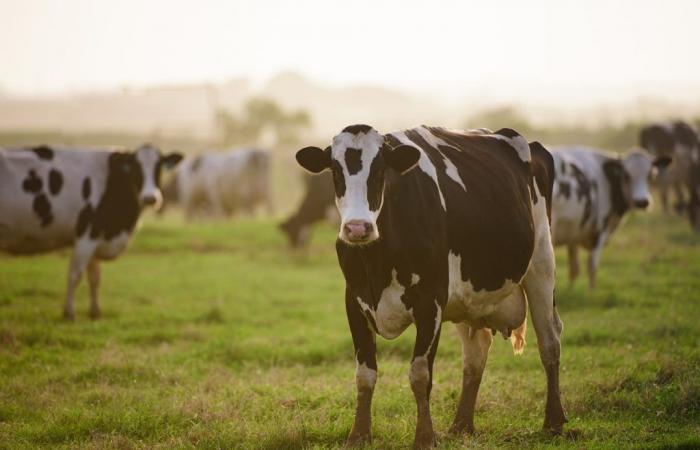At least one person in Texas has been diagnosed with bird flu after coming into contact with allegedly infected dairy cows, state officials said Monday. The announcement adds a worrying dimension to an outbreak that has affected millions of birds and marine mammals around the world and, most recently, cows in the United States.
Until now, there are no signs that the virus has evolved in ways that would help it spread more easily among people, federal officials said.
The patient worked directly with sick dairy cows, said Lara Anton, spokeswoman for the Texas Department of State Health Services. “We have tested about a dozen symptomatic people who work at dairies, and only one person has tested positive” for the virus, she said in an email.
The patient’s main symptom was conjunctivitis; the person is being treated with an antiviral and is recovering, according to the Centers for Disease Control and Prevention.
The Department of Agriculture announced the first cases in dairy herds in Texas and Kansas last week and, a few days later, in an additional herd in Michigan. Preliminary tests suggest that cows in New Mexico and Idaho may also be infected.
The virus was identified as the same version of H5N1, a subtype of influenza, which is circulating in North American birds. The CDC is working with state health departments to monitor other people who may have had contact with infected birds and animals, the agency said Monday.
It also advised people to avoid exposure to sick or dead birds and animals, as well as raw milk, feces or other potentially contaminated materials.
This is only the second case of H5N1 bird flu in people in the United States; the first was in 2022.
The risk to the general public remains low, experts said. But testing and analysis are ongoing, and there are many unanswered questions. “This is a rapidly evolving situation,” the USDA said in its announcement last week.
Here’s what you need to know:
Bird flu, or avian influenza, is a group of influenza viruses that are primarily adapted to birds. The particular virus in these new cases, called H5N1, was first identified in 1996 in geese in China, and in people in Hong Kong in 1997.
In 2020, a new, highly pathogenic form of H5N1 emerged in Europe and spread rapidly around the world. In the United States, it affected more than 82 million poultry, the worst bird flu outbreak in U.S. history.
Since the virus was first identified, sporadic cases have been found in people in other countries. But the vast majority resulted from prolonged direct contact with birds.
H5N1 does not yet appear to have adapted to spread efficiently between people, experts say.
How did cows get bird flu?
Cows were not considered a high-risk species. “The fact that they’re susceptible — the virus can replicate, it can make them sick — that’s something I wouldn’t have predicted,” said Richard Webby, an influenza researcher at St. Jude Children’s Research Hospital.
But this year reports of sick cows began to surface in Texas and New Mexico. Dead birds were also found on some of these farms, and laboratory tests confirmed that some cows were infected with bird flu.
There are a variety of ways the virus could have found its way into livestock. The likely route, several experts said, is that infected wild birds, which shed the virus in their feces, saliva and other secretions, contaminated the cows’ feed or water.
But other free-roaming animals known to be susceptible to the virus, such as cats and raccoons, may also have brought the virus to dairy farms.
How were the cows affected?
Although the virus is often fatal in poultry, it appears to be causing relatively mild illness in cows. “It’s not killing animals, and they appear to be recovering,” said Joe Armstrong, a veterinarian and livestock production specialist at the University of Minnesota Extension.
Last week, the USDA said there were no plans to “depopulate,” or kill, affected flocks, which is standard procedure when flocks of birds are infected with the virus.
The disease is mainly affecting older cows, which have developed symptoms including loss of appetite, low-grade fever and a significant drop in milk production.
The milk that cows produce is often “thick and discolored,” according to Texas officials. The virus has also been found in unpasteurized milk samples collected from sick cows.
It remains unclear whether the bird flu virus is the sole cause of all the symptoms and illnesses that have been reported, experts have warned.
What is the extent of the problem?
It is not clear. As of last Friday, the USDA’s National Veterinary Services Laboratory had confirmed bird flu infections in two herds in Texas, two herds in Kansas and one herd in Michigan.
Initial testing suggested that additional herds in Texas, New Mexico and Idaho may also have the virus, but those findings have not yet been confirmed by the national laboratory.
So far, the virus has only been found in dairy cows and not beef cattle. But because cows are not routinely tested for bird flu, and the illness has been relatively mild, there may be other infected herds that have escaped detection, experts said.
And the movement of cattle between states could carry the virus to new locations. The affected dairy in Michigan had recently imported cows from an infected herd in Texas.
When the cows were transported, the animals did not show any symptoms. The Idaho farm had also recently imported cows from an affected state, Idaho officials said.
How is it spreading?
This is a key and still unanswered question. It is possible that infected cows are picking up the virus independently, especially if shared food or water sources have been contaminated.
A more worrying possibility, however, is that the virus is spreading from cow to cow. On Friday, the USDA noted that “transmission among livestock cannot be ruled out.”
Several scientists said they would be surprised if there wasn’t some degree of cow-to-cow transmission. “How else could it move so quickly?” said Gregory Gray, an infectious disease researcher at the University of Texas Medical Branch.
If the virus can spread easily between cows, it could lead to larger, more sustained outbreaks. It would also give the virus more opportunities to adapt to its new mammalian hosts, increasing the risk of acquiring mutations that make it more dangerous to people.
How will officials know if bird flu adapts to spread between people?
Analyzing the genetic sequence of the virus from infected birds, cows and people could reveal whether H5N1 has acquired mutations that help it spread between people.
Scientists have been closely monitoring infections in birds and marine mammals, and now cows. So far, the virus does not appear to have the ability to spread efficiently between people.
In 2012, scientists showed that H5N1 was able to spread through the air between ferrets — a popular model for studying the transmission of respiratory viruses between people — after acquiring five mutations.
A strain of bird flu isolated from a Chilean man last year had two mutations that indicate adaptation to infect mammals. But these mutations have been seen before without the virus evolving further to spread between people, experts said.
This content was translated with the help of Artificial Intelligence tools and reviewed by our editorial team. Find out more in our AI Policy.






